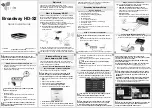
3
3597Q–DFLASH–6/11
Atmel AT45DB321D
Table 1-1.
Pin Configurations
Symbol
Name and Function
Asserted
State
Type
CS
Chip Select:
Asserting the CS pin selects the device. When the CS pin is deasserted, the
device will be deselected and normally be placed in the standby mode (not deep power-
down mode), and the output pin (SO) will be in a high-impedance state. When the device
is deselected, data will not be accepted on the input pin (SI).
A high-to-low transition on the CS pin is required to start an operation, and a low-to-high
transition is required to end an operation. When ending an internally self-timed operation
such as a program or erase cycle, the device will not enter the standby mode until the
completion of the operation.
Low
Input
SCK
Serial Clock:
This pin is used to provide a clock to the device, and is used to control the
flow of data to and from the device. Command, address, and input data present on the SI
pin are always latched on the rising edge of SCK, while output data on the SO pin are
always clocked out on the falling edge of SCK.
–
Input
SI
Serial Input:
The SI pin is used to shift data into the device. The SI pin is used for all data
input, including command and address sequences. Data on the SI pin are always latched
on the rising edge of SCK.
–
Input
SO
Serial Output:
The SO pin is used to shift data out from the device. Data on the SO pin
are always clocked out on the falling edge of SCK.
–
Output
WP
Write Protect:
When the WP pin is asserted, all sectors specified for protection by the
sector protection register will be protected against program and erase operations,
regardless of whether the enable sector protection command has been issued or not. The
WP pin functions independently of the software controlled protection method. After the
WP pin goes low, the content of the sector protection register cannot be modified.
If a program or erase command is issued to the device while the WP pin is asserted, the
device will simply ignore the command and perform no operation. The device will return to
the idle state once the CS pin has been deasserted. The enable sector protection
command and sector lockdown command, however, will be recognized by the device
when the WP pin is asserted.
The WP pin is internally pulled high, and may be left floating if hardware controlled
protection will not be used. However, it is recommended that the WP pin also be
externally connected to V
CC
whenever possible.
Low
Input
RESET
Reset:
A low state on the reset pin (RESET) will terminate the operation in progress and
reset the internal state machine to an idle state. The device will remain in the reset
condition as long as a low level is present on the RESET pin. Normal operation can
resume once the RESET pin is brought back to a high level.
The device incorporates an internal power-on reset circuit, and so there are no restrictions
on the RESET pin during power-on sequences. If this pin and feature are not utilized, it is
recommended that the RESET pin be driven high externally.
Low
Input
RDY/BUSY
Ready/Busy:
This open drain output pin will be driven low when the device is busy in an
internally self-timed operation. This pin, which is normally in a high state (through
an external pull-up resistor), will be pulled low during programming/erase operations,
compare operations, and page-to-buffer transfers.
The busy status indicates that the flash memory array and one of the buffers cannot be
accessed; read and write operations to the other buffer can still be performed.
–
Output
V
CC
Device Power Supply:
The V
CC
pin is used to supply the source voltage to the device.
Operations at invalid V
CC
voltages may produce spurious results and should not be
attempted.
–
Power
GND
Ground:
The ground reference for the power supply. GND should be connected to the
system ground.
–
Ground
Harman Kardon
AVR 151 Service Manual
Page 70 of 131
Summary of Contents for AVR 151/230C
Page 40: ...Harman Kardon AVR 151 Service Manual Page 40 of 131...
Page 41: ...Harman Kardon AVR 151 Service Manual Page 41 of 131...
Page 42: ...ISAHAYA ELECTRONICS CORPORATION Harman Kardon AVR 151 Service Manual Page 42 of 131...
Page 46: ...ISAHAYA ELECTRONICS CORPORATION Harman Kardon AVR 151 Service Manual Page 46 of 131...
Page 49: ...Harman Kardon AVR 151 Service Manual Page 49 of 131...
Page 50: ...Harman Kardon AVR 151 Service Manual Page 50 of 131...
Page 51: ...Harman Kardon AVR 151 Service Manual Page 51 of 131...
Page 61: ...Harman Kardon AVR 151 Service Manual Page 61 of 131...
Page 62: ...Harman Kardon AVR 151 Service Manual Page 62 of 131...
Page 75: ...Harman Kardon AVR 151 Service Manual Page 75 of 131...
Page 76: ...Harman Kardon AVR 151 Service Manual Page 76 of 131...
Page 89: ...Harman Kardon AVR 151 Service Manual Page 89 of 131...
Page 91: ...Harman Kardon AVR 151 Service Manual Page 91 of 131...
Page 92: ...Harman Kardon AVR 151 Service Manual Page 92 of 131...
Page 98: ...Harman Kardon AVR 151 Service Manual Page 98 of 131...
Page 106: ...Harman Kardon AVR 151 Service Manual Page 106 of 131...
Page 107: ...Harman Kardon AVR 151 Service Manual Page 107 of 131...
Page 108: ...Harman Kardon AVR 151 Service Manual Page 108 of 131...
Page 109: ...Harman Kardon AVR 151 Service Manual Page 109 of 131...
Page 110: ...Harman Kardon AVR 151 Service Manual Page 110 of 131...
Page 111: ...Harman Kardon AVR 151 Service Manual Page 111 of 131...
Page 112: ...Harman Kardon AVR 151 Service Manual Page 112 of 131...
Page 113: ...Harman Kardon AVR 151 Service Manual Page 113 of 131...
Page 114: ...Harman Kardon AVR 151 Service Manual Page 114 of 131...
Page 115: ...Harman Kardon AVR 151 Service Manual Page 115 of 131...
Page 116: ...Harman Kardon AVR 151 Service Manual Page 116 of 131...
Page 117: ...Harman Kardon AVR 151 Service Manual Page 117 of 131...
Page 121: ...Harman Kardon AVR 151 Service Manual Page 121 of 131...
Page 122: ...Harman Kardon AVR 151 Service Manual Page 122 of 131...















































